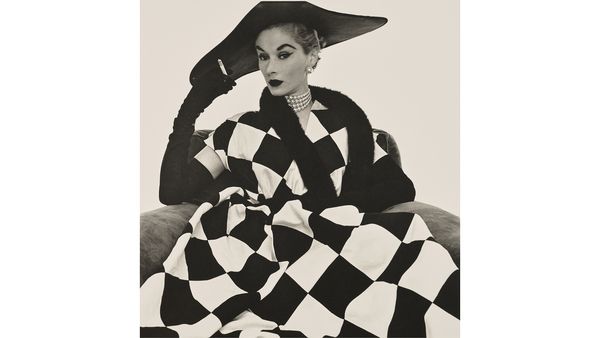Irving Penn, Harlequin Dress (Lisa Fonssagrives-Penn), 1950. Photographs New York.
Modern chic is something we now often take for granted, so jaded have we become. Irving Penn — among the greatest photographers of the 20th century — arguably invented it. Look no further than this, his most arresting portrait of the love of his life.
Let’s begin with the subject of this picture. Her name is Lisa Fonssagrives. Born in Sweden in 1911, she was trained from childhood as a painter, sculptor, and ballet dancer — and she went on to become the first supermodel in history. She was also the love of Irving Penn’s life. The two were married in 1950, several months before he shot this image, which was at the key formative moment of his early career as a photographer.
Her beauty speaks for itself. Penn’s camera is notably as authentic, honest, and truth-seeing as any in the world. No tricks of light, smoke or mirrors. Fonssagrives is quite simply a natural beauty on the level of Helen of Troy.
She is also a femme fatale. Her imperious pose — and her overall look — under Penn’s direction is as finessed and studied as any ever. This was the lead image of the legendary fashion story “Black & White” in the 1 April 1950 issue of Vogue magazine, which was only then rising to pre-eminence as the global bible for all that was chic and modern. The femme fatale archetype came to the fore in the 1941 classic The Maltese Falcon through the acting talents of Mary Astor playing opposite Humphrey Bogart. Yet it was never fully developed until this moment in time, owing to the rigors of wartime and post-war austerity which placed emphasis on women as supporters and nurturers. In no way does Penn represent his young bride as a maternal figure. She is clearly his Cleopatra.
The harlequin dress designed by Jerry Parnis is the co-star of this picture. Its whites are whiter than white, and its blacks blacker than black. Parnis’ designs were celebrated for bringing contemporary freshness to the era of full skirts and corseted waistlines. It is a sumptuous, modern visual feast and a bold statement of supreme confidence. At first, one is tempted to connect this harlequin pattern to the Italian Baroque Commedia dell'arte pantomime theater as it is the signature costume motif of the central character, Arlecchino. Notably, 1950 found American elites looking to the style icons of Rome (and Florence). Milan design was also reforming, post-Mussolini. And the great Venetian textile mills were beginning to call the shots (behind the scenes) on couture fabrications in all the world’s fashion capitols. The long calfskin opera gloves Fonssagrives wears could not feel more Italian.
However, it must be noted that this is no mere homage to Bella Italia. For starters, the Harlequin in the Tarot is the joker/trickster. Middle Dutch hellekijn and the Old French hellequin reference Hell and mean a kind of demon. As author Florie Gray notes, “In the translation from French to English, the harlequin lost his demonic quality and became a clown. But the traditional black/white contradistinction of this iconic pattern is an Angel/Devil dichotomy that most brings to mind Jung’s trickster, an important alchemical archetype.”
Then there is Penn’s startling mastery of the analog chemistry in his artisanal photo-printing process. This is platinum-palladium printing at its most finessed and finest. Even in New York City, media capital of the world by the 1950s, you couldn’t just run around the corner to discover an accomplished master of this craft (like you could a pastrami sandwich). Platinum and palladium are among the most extraordinary and expensive white metals in the world. Long ago, they were also key components of the alchemist’s arsenal. And they were far too dear for your average-Joe fashion photographer to play around with. And yet, in his journey to mastery, Penn spared no expense and went to excruciating pains to raise this medium to unprecedented heights. Why? Because both are superlatively lightfast (non-fading) as compared to the conventional materials used by most — and miraculously complementary also, with platinum imparting rare warmth to the highlights and palladium the same in the shadows. This matrix is also a harlequin.
All that said, there is also something New World and fundamentally American about this image. The Lilly Daché satin hat that Lisa wears alludes to the tricorne cap of liberty, favored in the 18th century revolutions as a symbol of staunch democratic values. These values were hot on the minds of the American people and its government at this time, after liberating Europe. The Benson & Hedges she flagrantly wields as a wand or a scepter dually alludes to the iconic and popular image then in circulation of the militiaman on the march, with shouldered musket. It goes without saying, it also stood as a symbol of women’s emancipation and empowerment.
Could it be more clear in this image that Irving Penn loved his wife Lisa Fonssagrives as few men ever will love theirs — and that she loved him here perhaps even more, with all her heart?
Discover More from Photographs New York >
Auction /
Photographs, New York
Morning Session
4 April, 10am ET
Afternoon Session
4 April, 2pm ET
432 Park Avenue, New York (map)
Recommended Reading
New York as You've Never Seen It >
A Legend’s Rise: Peter C. Bunnell >
The Start of a Brilliant Career >
